Growing White Sage: From Improved Seed Germination to Useful Harvest
Medicinal herbsWhite sage (salvia apiana) has been used for centuries by Native Americans for medicinal and ceremonial purposes. This shrubby desert native produces silver leaves that grow in a rosette arrangement on straight stalks. Young leaves start out green and turn white as they get older and when they are dried.

The natural habitat of white sage is a small geographic area from Santa Barbara County to Baja California, Mexico. Unfortunately, as white sage has grown in popularity over the years, its habitat has been encroached from development, and the plants have been over-harvested and poached in protected areas.
Growing your own white sage from seed is the responsible way to produce harvestable plants. We'll walk you through the process from seed germination to harvest.
Quick Links
How to Grow White Sage From Seed
White sage seeds have a very low germination rate. While this may be frustrating when starting plants from seed, it’s part of the natural process. To survive its native desert habitat, not all white sage seeds sprout at the same time. Many times germination rates are only 20%. The seeds aren’t duds; they just take their own sweet time.

White Sage Seed Germination Tips
These basic tips will help improve germination rates. Start by planting seeds indoors and using scarification, heat, light, and the right amount of moisture.
- Scarification. White sage seeds have a tough outer coating that protects them in nature. Scarification will break down the tough shell and help the seeds germinate faster. To scarify white sage seeds, place them on a piece of fine-grit sandpaper and then take a sanding block or another piece of sandpaper and rub it lightly over the seeds. This will remove the hard outer layer without damaging the interior seed.
- Heat. White sage loves heat. To ensure successful seed germination, keep the soil and air temperature between 70 and 85ºF.
- Light. White sage seeds need light to germinate. Use grow lights when starting seeds indoors.
- Sprinkle 15-20 seeds in each tray or pot. Then, lightly press them into the soil. Planting white sage seeds too deeply will keep them from receiving the light they need to germinate.
- Mist the seeds with a spray bottle to keep the soil moist but not soggy. You can use a humidity dome to keep the seeds from drying out before they germinate.
While you will have seeds germinating in as early as 7 days, it can take much longer, even up to 21 days. In nature, it can take seeds a full year to germinate! But with these tips, your white sage seeds should germinate more quickly. With scarification, heat, and light, we had an almost 100% germination rate.

Transplanting White Sage Seedlings
As the white sage seedlings grow, they will need bright, full sunlight. Using a grow light is recommended. Continue to keep the soil lightly moist.
After the seedlings have developed true leaves and are 3 inches tall, they can be transplanted outdoors. Once the soil has warmed and all danger of frost has passed, they will be ready to acclimate to life outside. To reduce transplant shock, harden off the seedlings before transplanting.
Space plants 12 to 18 inches apart and water deeply.
While there are more than 700 species of salvias with different tastes and scents, white sage (salvia apiana) is unique. As a sun-loving, drought-tolerant plant, it can grow well in a suitable climate.
Growing your own white sage can take patience, but the harvest is rewarding.

Growing White Sage Plants
Replicating the natural habitat of white sage will give it the best growing conditions. White sage loves the sun and grows on sunny hillsides where the water runs off quickly. The region where it grows is very mild, with temperatures ranging from 40 to 80°F. The summers are warm and dry, and the winters are cool and cloudy.
White sage is generally hardy in zones 7-9. Plants can grow 3-5 feet tall and from 3-8 feet wide and are a perennial in the right habitat. While plants are still developing deep taproots in the first year, white sage will need weekly watering. After that, the roots will usually get all the water they need from natural rain amounts and won’t require additional watering.
White sage plants can be grown in pots in colder zones to be taken inside during the winter months. It does not do well in cold temperatures. However, planting white sage near a wall and surrounding it with rocks can add radiant heat. Also, piling sand over the plants in the colder months can help keep them warm and dry. No fertilizer is necessary, as white sage prefers low-nutrient conditions. Add sand and perlite to create a fast-draining soil.
White sage is a hardy perennial, but it does have a few issues that can affect it. It can tolerate humidity but can be susceptible to powdery mildew, rust, and root rot. Sudden wilting can indicate poor drainage or root rot. Aphids, whiteflies, and spider mites can also be a problem. Neem oil can be an effective treatment but wait 10 days after applying it before harvesting.
During the summer, white sage will bloom with spikes of white flowers. Its flower spikes soar 2-5 feet above the foliage, with small white-to-lavender flowers that are beloved by pollinators, such as bees, hummingbirds, and beneficial insects. It is so beloved by bees that it is sometimes called bee sage.

White Sage Harvesting Tips
There are simple ways to harvest white sage to keep the plant healthy and growing. The easiest way is to pick individual leaves as needed.
When harvesting larger amounts, make sure you cut the pliable part of the stem and not the woody section. Use sharp garden shears and cut just above a node. A node is the joint in the stem where side branches are growing. Cutting this top part off will encourage the side branches to continue growing.
Take only the top clusters of leaves and never more than 1/3 of the plant at a time. Harvest leaves and sprigs before the plant starts flowering. Spread them out and allow them to air dry before wrapping them into bundles or storing them.

How to Use White Sage
White sage is prized for its use in herbal remedies, energy work, and healing ceremonies.
- In traditional medicine, white sage was boiled in water to make a strong-scented liquid for washing the body. The antibacterial effect helped to eliminate body odors and decrease sweating.
- Dried leaves are traditionally burned as incense, known as smudging. The smudging process involves lighting smudge sticks (tightly wrapped bundles of dried sage leaves), blowing them out, and allowing the smoke to escape into the air.
- White sage is known for its ability to ease cold symptoms such as congestion and sore throat.
- Steam inhalation can relieve congestion and ease cold symptoms. Boil sage leaves for 5-10 minutes, and then with a towel over your head, breathe in the aromatic steam.
- Steep a few leaves in boiling water to make a hot tea with lemon and honey.
- White sage can be infused into oils to make massage oils, ointments, body butters, salves, and lip balms.
- Because of its high eucalyptol content, a strong infusion can be used as a gargle for a sore throat.
- Traditionally, white sage was used to reduce hot flashes, probably due to its phytoestrogens.
- The medicinal properties of white sage make it a beneficial addition to a hot foot soak.

Cautions: White sage does contain thujone - which in large amounts can cause anxiety, confusion, and kidney problems. Do not use if epileptic or pregnant. As with all herbal medicines, use caution and consult a medical professional when taking them internally.
When you grow your own white sage plants, you won't have to worry about where they came from. This growing guide and seed germination tips will ensure you have a sustainable harvest of white sage and enjoy its many benefits.
Written by Beverly Laudie










Monah, it sounds like you are concerned about the plant roots interfering with your underground pipes. From our experience with white sage, this shouldn’t be a problem.
Can I plant white sage where I know my water pipes are 3 ft deep below the plant? The pipes are new not old running underground from the street to my property? TIA
Leave a comment